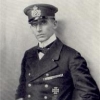Badung Strait-19 February 1942
We had our first face to face game in over a year. There were only three of us so, we wanted a small scenario. We are also involved in playing the “Defending the Malay Barrier” campaign so we wanted a scenario related to the campaign. We turned to the Dutch Supplement and selected Badung Strait.
Time: 2200 hours Moon: Full Wind: Force 2 from the East. Squalls: None
Max Visibility: 20,000 yards
It was a moon lit night and Rear Admiral Randy Miles (aka Doorman) was on the bridge of his flagship HrMs De Ruyter. HrMs Java trailed him astern and a mixed Dutch and American destroyer division comprised of HrMs Piet Hein, USS John D. Ford and USS Pope followed Java.
A second Allied group consisting of HrMs Tromp and the American destroyers, USS John D. Edwards, USS Stewart, USS Pillsbury and USS Parrott was about 2 to 3 hours behind.
The Japanese had landed a battalion of their 48th Infantry Division on Bali and Allied LBA had bombed the landing force and caused some damage. Doorman’s mission was to finish what the Airedales had started and sink any Japanese shipping in the Strait.
The ABDA Force was heading NE and steaming at 25 knots with the cruiser division in line ahead with their destroyer division behind them in a column. They had been heading NE for about 30 minutes in the Strait when lookouts on De Ruyter (could see 6, 000 yards) and Piet Hein (could see 8,000 yards) both acquired what turned out to be two destroyers on their port quarter. Doorman called for full speed and a change of course to port to close when 2 torpedoes struck USS Pope and 3 more struck USS John D. Ford sinking both destroyers within 3 minutes.
De Ruyter struck back and hit the lead destroyer (Oshio) setting her afire. Return fire from Oshio bounced ineffectively off DeRuyter. Java could not see anything but Piet Hein opened on the second Japanese destroyer (Arashio). Java now able to see the burning Oshio joined De Ruyter in pummeling her with 5.9”. Oshio’s return fire was smothered under the deluge 5.9” and her speed dropped while she continued to burn. Oshio was also illuminated by many smaller fires from the cruiser fire.
Piet Hein traded shots with Arashio and suffered for it. First was a hit in her engineering (which she repaired immediately) and then a bulkhead which took 6 minutes to repair. Arashio was also suffering when Java joined in. Arashio now on fire with her guns being ruthlessly silenced slowly lost speed. Java also suffered a bulkhead hit.
Piet Hein finally saw what the Allies were there for; the Sagami Maru chugging along at 10 knots. Piet Hein having lost her forward torpedo mount continued to close the range smothering the Sagami Maru’s lone 3” and damaging a bulkhead. Sagami Maru had gone dead in the water and the two Japanese destroyers were not far from it but refused to give up the fight.
Captain Robert Bishopsan had fought gallantly, making moral twice but Asashio and Michishio (while approaching) were too far away to intervene in time to save the valiant captain or his crews.
We called it an Allied victory and ended it there.








